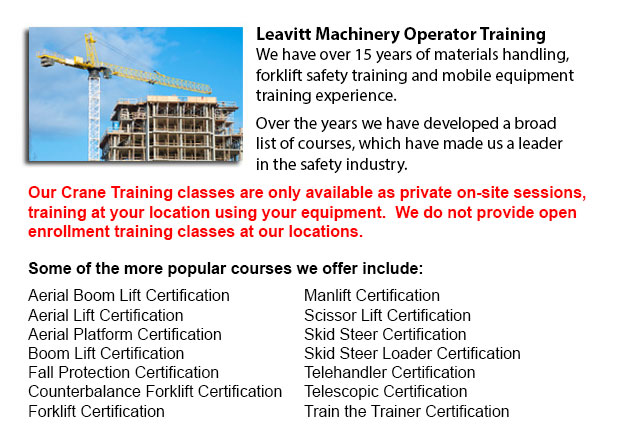
Overhead Crane Safety Training Langley - Overhead crane safety training equips operators with skills and knowledge regarding crane safety precautions, materials handling, accident avoidance, and equipment and stock protection. Trainees would learn the kinds of overhead cranes, their capabilities and their uses in various industry settings. For operators who are licensed and trained, the shift in liability moves to the operator from the company. Therefore, the course emphasizes individual operator duties.
The operators in the overhead safety training program would be given instruction about the correct ways for carrying out checks: the pre-shift inspection and the more detailed in-depth inspection. These are critical daily routines that should be logged. Correctly recorded pre-shift checks help to protect the business from liability in the event of an accident. Pre-shift checks likewise prevent accidents, damage and costly repairs. Operators learn how to designate a particular person to handle inspections, how to report problems, and how to maintain the log book.
Every inspection must be documented and carried out on a regular basis. Things that must be checked for possible problems, include: hooks for cracks, increases in the throat opening, degree of twist; hoist ropes for corrosion, loss of diameter, worn wires, broken wires, kinks and bird caging, heat and chemical damage; chains for nicks and gouges, twists, cracks and corrosion, distortion, excessive wear, pits, stretching, damage from extreme heat.
The operator will get to learn the correct techniques about proper rigging procedures. The process of rigging includes the understanding of the manufacturer's data plate, determining the material weight to be lifted, choosing the gear, and using safe practices to secure the load. The course cover in detail the following: safe working loads, and the capacities of chains, ropes, slings, hooks and shackles.
It is vital to understand who could use the cranes at your facility, physical requirements of the job, and operator qualifications required for specialized job and permits. Safety is a top priority when utilizing in the vicinity of pedestrian traffic.
The duties involved in the safe crane use includes checking for hydraulic leaks, undertaking visual inspections, checking the safety guards, testing the controls, examining the hoist rope and hook, braking mechanisms and limit switches. Proper reporting procedures are critical. These subject matters are all covered in depth in the course.
Right lifting and moving methods with cranes and hoists are included in the course. Operators would become skilled in hand signals. Training includes how to raise the load, attach the load, set the load, unhook the slings and abort a lift.
Moving the load involves a number of steps: stopping and starting procedures, controlling and guiding the load, observing working conditions and working with signals. Operators must know how to proceed in the event of a power failure. The course covers methods for lowering the load and removing the slings, parking the crane, storage equipment, and securing an outdoor and indoor crane.
-
Boom Lift Certification Langley
Boom Lift Certification Langley - Making use of elevated work platforms allow for maintenance operations and work to be performed at elevated work heights which were otherwise unreachable. Boom Lift Certification Training educates workers about safel... More -
Boom Lift Training Langley
Boom Lift Training Langley - Elevated work platforms, likewise referred to as aerial platforms, enable workers to carry out tasks at heights which would otherwise be unreachable. There are various types of lifts intended for various site applications... More -
Wheel and Track Loader Training in Langley
Lift trucks are available in a variety of various units that have varying load capacities. The majority of typical lift trucks used in warehouse settings have load capacities of 1-5 tons. Larger scale models are used for heavier loads, like loading s... More -
Counterbalance Forklift License Langley
Counterbalance Forklift License Langley - When operated by completely trained operators, forklifts could become a major advantage for firms and companies. We can offer your employees a thorough training program which consists of all factors of operat... More -
Aerial Lift Ticket Langley
Aerial Lift Ticket Langley - A boom truck is frequently recognized by the cable and telephone company vans that have the elongated arm folded over their roofs. Commonly, a bucket-like apparatus sits at the extension of extendable arms. Often termed a... More -
Aerial Lift Training Langley
Aerial Lift Training Langley - An aerial work platform is a mechanized access platform. This particular device provides access to otherwise not accessible places for equipment or people. Likewise known as an aerial device or elevating work platform,... More -
Wheel Loader Operator Training Langley
Wheel Loader Operator Training Langley - To be able to raise considerable weights, industrial cranes utilize pulleys and levers. In the past, Romans utilized cranes to construct huge monuments making the origin of these equipment at least two thousan... More -
Manlift Safety Training Langley
Manlift Safety Training Langley - It is important for competent Manlift operators to be aware of the connected dangers which come with particular kinds of scissor lifts. They must be able to operate the scissor lift in a way that protects not just th... More

Forklift Training Langley
TOLL FREE: 1-888-254-6157
Langley, British Columbia
forklifttraininglangley.com
Email Us
About Us


